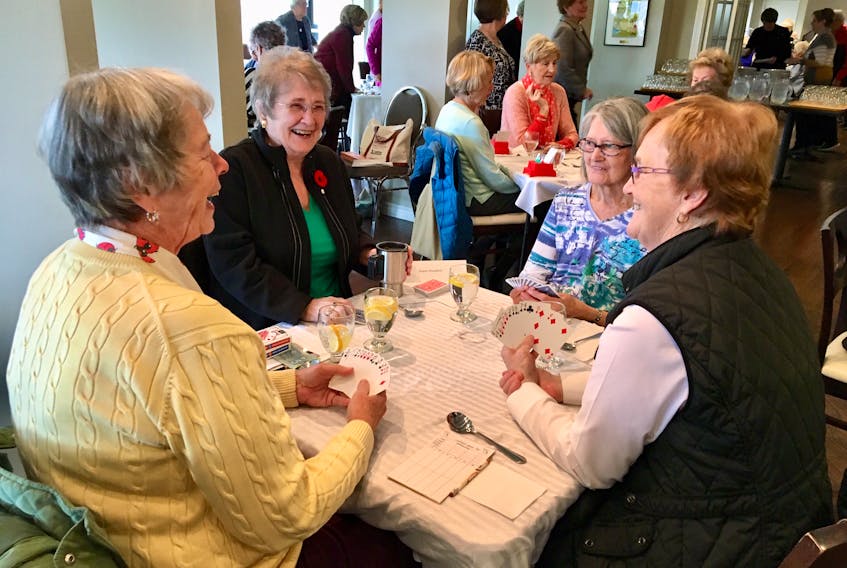It’s just past noon on a Tuesday afternoon in November and the hum of chatter and sudden shrills of laughter can be heard throughout the Bally Haly Golf and Curling Club in St. John’s.
The delightful aroma of simmering soup fills the main floor, where more than 140 female senior citizens gathered, as they do every week, to play their favourite card game — bridge.
The classic game of strategy featuring two teams of two and countless bids is challenging, but these women, some in their 90s, are no slouches.
Watching them hold their handfuls of cards, it’s easy to see they know how to play their hands.
“Oh, they’re very good players,” said Lillian Crawford, who helps co-ordinate the league. “Some of them have been playing for decades.”
There are prizes for the top players each week, but for those to come out to play, it’s not about winning.
“We’re not serious at all,” Crawford said. “Yes, they want to play well and they like winning, but it’s more social for them. It’s a nice afternoon out.”
It’s not just a game for this group — it has become a big part of their lives.
The only big demand is for spots at one of the tables of four.
If a player drops out or can’t make it, there’s huge interest in getting that spot.
“It’s like successor’s rights,” said Crawford, who has been involved with the league for the past decade. “They like to sit in certain spots at the table.”
Derived from the 17th-century game whist, bridge is a trick-taking card game that was once primarily played by the English nobility.
According to Larry Dohey, manager of collections and special projects at The Rooms, playing cards has been a popular activity in Newfoundland since the early days, but it seems there was a socio-economic statement about the particular type of cards played. Bridge tended to be a game popular amongst the upper class.
Archives show that in December 1914, Margaret (Lady) Davidson — wife of the governor of Newfoundland, Walter Edward Davidson — declared there would be no “dinners or dances in Government House on Military Road, St. John’s, during the Christmas season,” as she thought, “it would be inappropriate to have extravagant affairs while the war raged in Europe.” Instead, she consented to games of bridge for relaxation.
Governor Davidson wrote in his diary he was very pleased that “this form has received her approval.”
But it’s no wonder the working class of Newfoundland had other things to think about.
“My mother had 10 children and my father was a firefighter,” Alice Seviour said, sitting at one of the other tables. “They were too busy working and would be too exhausted at night to be playing (bridge).”
Nowadays, bridge is played by people from all walks of life in this province — especially baby boomers, who have retired and look to stay in contact with friends, meet new people and keep their minds sharp.
There’s another smaller league (they call it “Little Bridge”) at Bally Haly, while there are also leagues and other bridge events played at dozens of places throughout the metro area alone. There’s also a Bridge on the Edge league, played at the Swilers Rugby Club.
“It’s amazing how popular it is here,” Crawford said, as the women break for lunch when pots of soup and trays of sandwiches and cookies are brought from the kitchen.
Once lunch is done, it’s back to playing until 3:30 p.m.
“They just love it,” she said. “They look forward to it every week. It’s a wonderful way to spend an afternoon for $15.”
Crawford didn’t get involved in bridge until late in life – when she retired.
“But I’m glad I did,” she said, adding that the key to the game is communication. “It’s a really interesting game.”

One particular table in the group knows the game very well.
Douglass Frampton is 95 years old and has been playing bridge for five decades and wouldn’t miss a week of playing.
“Oh, I love it,” Frampton said. “You get to use your brain. It’s really good for the memory, you know.”
Another woman at her table, who just wanted to be known as Eileen, added, “Young people just don’t understand. They have so much to do in life these days, they don’t appreciate how really satisfying it can be sitting and playing something like this.”
Verna Smith, seated with Seviour, is a retired teacher who teaches the game, with her husband Boyd Smith, at the Mews Community Centre and admitted the game can be intimidating, but it doesn’t take long to catch on.
“It takes strategy, but it’s not as difficult as you’d think,” Smith said. “You can enjoy it at whatever level you are. … And I’ve never met a grumpy person. People love to learn it. They’re like sponges.
“There’s no way you get sick of it. It’s very addictive. You always want to keep improving.”
Smith says she enjoys teaching the game and is doing all she can to pass her knowledge on to the next generation — one of her daughters and some of her grandchildren.
“They enjoy it just as much as we do,” Smith said.
For Smith and her friends, it has become a big part of their lives.
“It’s very rewarding,” she said before adding, with a smile, “Plus, when you’re playing, you don’t think about your aches and pains.”
INTERESTING BRIDGE FACTS
Historians who study playing cards will remind us that:
- The four suits signify the four seasons of the year.
- The 13 cards per suit represent the lunar months of the year.
- When the numerical value of each suit is calculated, the total is 364. If we add the joker to the count, it becomes 365, thereby representing the number of days in a year.
- The 52 cards in the deck also signify the 52 weeks in a year.
- The red and black colours of the cards may represent day and night.
The four suits can also be read as symbols of society and human energy:
- Clubs represent both the poor and achievement through work.
- Diamonds represent the merchant class and the excitement of wealth creation.
- Hearts represent the clergy and the struggle to achieve inner joy.
- Spades represent the warrior class.
Source: Larry Dohey, manager of collections and special projects, The Rooms









